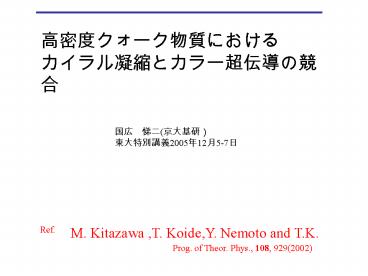M. Kitazawa ,T. Koide,Y. Nemoto and T.K.
1 / 20
Title: M. Kitazawa ,T. Koide,Y. Nemoto and T.K.
1
????????????? ????????????????
?? ??(????) ??????2005?12?5-7?
M. Kitazawa ,T. Koide,Y. Nemoto and T.K.
Ref.
Prog. of Theor. Phys., 108, 929(2002)
2
1 Introduction
Color Superconductivity(CSC)
Cooper instability
In sufficiently cold fermionic matter, any
attractive interaction leads to the instability
to form infinite Cooper pairs.
QCD at high density
asymptotic freedom Fermi
surface attractive channel in one-gluon exchange
interaction
D.Bailin and A.Love, Phys.Rep.107,325(84)
Attractive!
T
Hadrons
Cold, dense quark matter is color superconducting
CSC
m or r
0
3
Recent Progress in CSC (98)
The di-quark gap D can become 100MeV.
M.Alford et al.,PLB422(98)247 / R.Rapp et
al.,PRL81(98)53 / D.T.Son,PRD59(99)094019
The possibility to observe the CSC in neutron
stars or heavy ion collisions
Another symmetry breaking pattern
Color-flavor locked (CFL) phase at high
density(mq gtgtms)
M.Alford ,K.Rajagopal, F.Wilczek,Nucl.Phys.B537(9
8)443
CFL
2SC
d
s
R.Pisarski,D.Rischke(99) T.Schaefer,F.Wilczek(99
) K.Rajagopal,F.Wilczek(00)
d
d
u
u
s
d
u
d
u
u
4
Phase Diagram of QCD
T
End point of the 1st order transition
M.Asakawa, K.Yazaki (89)
Chiral Symmetry Broken
2SC
CFL
µ
0
K. Rajagopal and F. Wilczek (02), At the
Frontier of Particle Physics / Handbook of QCD
Chap.35
Various models lead to qualitatively the same
results.
NJL-type 4-Fermi model Random matrix
model Schwinger-Dyson eq. with OGE
J.Berges, K.Rajagopal(98) / T.Schwarz et al.(00)
B.Vanderheyden,A.Jackson(01)
M.Harada,S.Takagi(02) / S.Takagi(02)
However,
almost all previous works have considered only
the scalar and pseudoscalar interaction in qq and
qq channel.
5
Vector Interaction
density-density correlation
The importance of the vector interaction is well
known
Hadron spectroscopy Klimt,Luts,Weise
(90) Chiral restoration Asakawa,Yazaki (89) /
Buballa,Oertel(96)
m
Vector interaction naturally appears in the
effective theories.
Instanton-anti-instanton molecule model
Shaefer,Shuryak (98)
Renormalization-group analysis N.Evans et al.
(99)
6
Effects of GV on Chiral Restoration
GV?Large
First Order
Cross Over
As GV is increased,
Chiral restoration is shifted to higher
densities. The phase transition is weakened.
Asakawa,Yazaki 89 /Klimt,Luts,Weise 90 /
Buballa,Oertel 96
7
Chiral Restoration at Finite m
E
E
m
Baryon density suppresses the formation of q-q
pairing.
Chiral condensate ( q-q condensate )
0
0
mSmall mLarge
CSC ( q-q condensate )
Small Fermi sphere
Large Fermi sphere leads to strong Cooper
instability
8
2 Formulation
Nambu-Jona-Lasinio(NJL) model (2-flavors,3-colors)
Parameters
current quark mass
To reproduce the pion decay constant the
chiral condensate
Hatsuda,Kunihiro(94)
is varied in the moderate range.
9
Thermodynamic Potential in mean field
approximation
chiral condensate
di-quark condensate
Quasi-particle energies
cf.) s-w model
10
Gap Equations
The absolute minimum of w gives the equilibrium
state.
Gap equations ( the stationary condition)
T0MeV, m314MeV GV0
If there are several solutions, one must choose
the absolute minimum for the equilibrium state.
11
Effect of Vector Interaction on w
Contour map of w in MD-D plane
T0 MeV m314 MeV
m
small r
large M
large r
small m
Vector interaction delays the chiral restoration
toward larger m.
12
3 Numerical Results
First Order
Second Order
Cross Over
Phase Diagram
The existence of the coex. phase
Berges,Rajagopal(98)Rapp et al.(00)
?
Order Parameters
MD Chiral Condensate
D Diquark Gap
13
As GV is increased
(1)
The critical temperatures of the cSB and CSC
hardly changes.
It does not change at all in the T-r plane.
14
(2)
The first order transition between cSB and CSC
phases is weakened and eventually disappears.
(3)
The region of the coexisting phase becomes
broader.
Appearance of the coexisting phase becomes robust.
(4)
Another end point appears from lower
temperature, and hence there can exist two end
points in some range of GV !
15
Order Parameters at T0 (in the case of chiral
limit)
Chiral restoration is delayed toward larger m.
cSB survives with larger Fermi surface.
Stronger Cooper instability is stimulated with
cSB.
The region of the coexisting phase becomes
broader.
400
m MeV
300
16
m
Large fluctuation owing to the interplay between
cSB and CSC is enhanced by GV.
Contour of w with GV/GS0.35
T 22MeV
12MeV
15MeV
5MeV
17
End Point at Lower Temperature
As GV is increased,
p
pF
cSB
CSC
Coexisting phase becomes broader .
p
pF
D becomes larger at the phase boundary between
CSC and cSB. The Fermi surface becomes
obscure.
This effect plays a role similar to the
temperature, and new end point appears from lower
T.
18
Phase Diagram in 2-color Lattice Simulation
J.B.Kogut et al. hep-lat/0205019
19
Summary
The vector interaction enhances the interplay
between cSB and CSC.
The phase structure is largely affected by the
vector interaction especially near the border
between cSB and CSC phases.
Coexistence of cSB and CSC, 2 endpoints phase
structure, Large fluctuation near the border
between cSB and CSC
Future Problems
More deep understanding about the appearance of
the 2 endpoints
The calculation including the electric and color
charge neutrality.
20
Phase Diagram in the T-r plane































